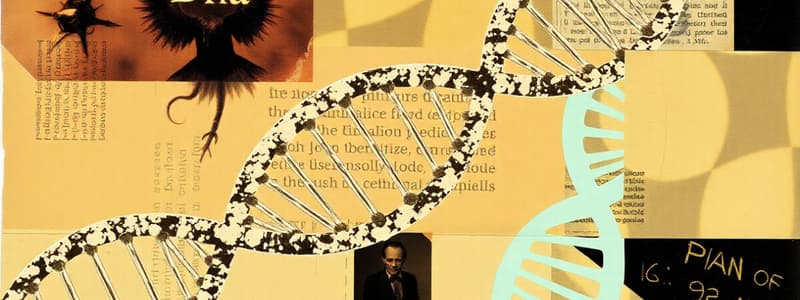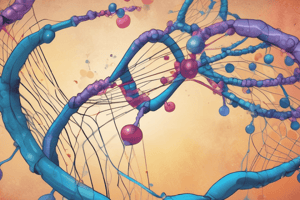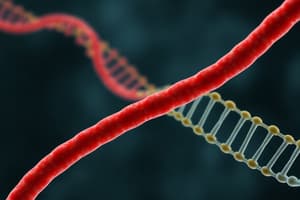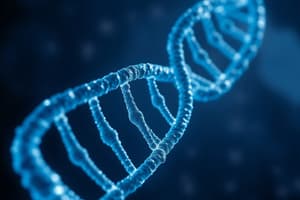Podcast
Questions and Answers
Which of the following best describes the primary focus of the Molecular Biology (MPRM0107) course?
Which of the following best describes the primary focus of the Molecular Biology (MPRM0107) course?
- A broad survey of human diseases, their symptoms, and traditional treatment methods.
- The detailed examination of molecular processes within cells, particularly nucleic acids and their regulation. (correct)
- The study of plant physiology and its application to agricultural practices.
- An overview of general biological principles with a focus on ecological relationships.
A student is interested in learning about the techniques used to analyze DNA sequences. In which part of the Molecular Biology (MPRM0107) course would they most likely find this information?
A student is interested in learning about the techniques used to analyze DNA sequences. In which part of the Molecular Biology (MPRM0107) course would they most likely find this information?
- The overview of basic cell structures and organelle functions.
- The section on the historical development of molecular biology as a field.
- The section on nucleic acid replication and repair mechanisms.
- The discussion of molecular and biochemical techniques for isolating, replicating, and analyzing nucleic acid sequences. (correct)
If a researcher is studying how gene expression is controlled in a cell, which area of molecular biology, as covered in the Molecular Biology (MPRM0107) course, would be most relevant?
If a researcher is studying how gene expression is controlled in a cell, which area of molecular biology, as covered in the Molecular Biology (MPRM0107) course, would be most relevant?
- Techniques for replicating nucleic acid sequences.
- The control of gene expression. (correct)
- The mechanisms of DNA damage and repair.
- The structure and function of proteins.
A medical researcher is investigating the genetic basis of a particular human disease. How would the content of the Molecular Biology (MPRM0107) course be most applicable to their work?
A medical researcher is investigating the genetic basis of a particular human disease. How would the content of the Molecular Biology (MPRM0107) course be most applicable to their work?
Considering the course description, which of the following topics would NOT be a primary focus of the Molecular Biology (MPRM0107) course?
Considering the course description, which of the following topics would NOT be a primary focus of the Molecular Biology (MPRM0107) course?
What structural feature of DNA is most directly responsible for its ability to store and transmit genetic information?
What structural feature of DNA is most directly responsible for its ability to store and transmit genetic information?
If one strand of a DNA molecule has the sequence 5'-ACGTCG-3', what is the sequence of the complementary strand?
If one strand of a DNA molecule has the sequence 5'-ACGTCG-3', what is the sequence of the complementary strand?
What is the primary difference between a nucleotide found in DNA versus one in RNA?
What is the primary difference between a nucleotide found in DNA versus one in RNA?
How does the antiparallel arrangement of DNA strands contribute to DNA's function?
How does the antiparallel arrangement of DNA strands contribute to DNA's function?
In the context of DNA structure and function, what is the significance of hydrogen bonds between base pairs?
In the context of DNA structure and function, what is the significance of hydrogen bonds between base pairs?
What key information did Rosalind Franklin's X-ray crystallography contribute to Watson and Crick's DNA model?
What key information did Rosalind Franklin's X-ray crystallography contribute to Watson and Crick's DNA model?
Which component of a DNA nucleotide is primarily responsible for carrying genetic information?
Which component of a DNA nucleotide is primarily responsible for carrying genetic information?
Watson and Crick were awarded the Nobel Prize for their work on DNA. What was the primary contribution of Maurice Wilkins to this discovery?
Watson and Crick were awarded the Nobel Prize for their work on DNA. What was the primary contribution of Maurice Wilkins to this discovery?
In the diagram of a nucleotide, which carbon on the deoxyribose sugar is connected to the nitrogenous base?
In the diagram of a nucleotide, which carbon on the deoxyribose sugar is connected to the nitrogenous base?
Which scientist had a background in physics and contributed significantly to the discovery of the structure of DNA?
Which scientist had a background in physics and contributed significantly to the discovery of the structure of DNA?
Which of the listed scientists directly contributed experimental data crucial for Watson and Crick's DNA model, specifically through X-ray diffraction?
Which of the listed scientists directly contributed experimental data crucial for Watson and Crick's DNA model, specifically through X-ray diffraction?
A student is asked to describe the hierarchy of genetic material organization. Which of the following sequences accurately represents the progression from smallest to largest scale?
A student is asked to describe the hierarchy of genetic material organization. Which of the following sequences accurately represents the progression from smallest to largest scale?
In a Team-Based Learning (TBL) activity, what is the immediate next step after students individually complete a set of MCQs on a given concept?
In a Team-Based Learning (TBL) activity, what is the immediate next step after students individually complete a set of MCQs on a given concept?
A researcher is studying the rate of DNA replication in a bacterial cell. Which enzyme would be the MOST relevant to measure the activity of to understand the speed of replication?
A researcher is studying the rate of DNA replication in a bacterial cell. Which enzyme would be the MOST relevant to measure the activity of to understand the speed of replication?
A scientist discovers a new chemical mutagen that causes a specific type of DNA damage. Which DNA repair system would MOST likely be involved if the damage is the removal of a nitrogenous base?
A scientist discovers a new chemical mutagen that causes a specific type of DNA damage. Which DNA repair system would MOST likely be involved if the damage is the removal of a nitrogenous base?
If a mutation occurs in a region of DNA that codes for a protein, but there is no change in the amino acid sequence of the protein, then what kind of mutation is it?
If a mutation occurs in a region of DNA that codes for a protein, but there is no change in the amino acid sequence of the protein, then what kind of mutation is it?
Which of the following best represents the central dogma of molecular biology?
Which of the following best represents the central dogma of molecular biology?
A clinician is investigating the potential of using molecular techniques to diagnose a genetic disease. Which of these techniques is MOST suitable for identifying a specific DNA sequence associated with the disease?
A clinician is investigating the potential of using molecular techniques to diagnose a genetic disease. Which of these techniques is MOST suitable for identifying a specific DNA sequence associated with the disease?
What would MOST LIKELY be the outcome if a cell's DNA ligase enzyme were non-functional?
What would MOST LIKELY be the outcome if a cell's DNA ligase enzyme were non-functional?
A researcher is aiming to study gene expression levels in a cancer cell line after treatment with a novel drug. Which molecular technique would be the MOST appropriate for quantifying mRNA levels of multiple genes simultaneously?
A researcher is aiming to study gene expression levels in a cancer cell line after treatment with a novel drug. Which molecular technique would be the MOST appropriate for quantifying mRNA levels of multiple genes simultaneously?
If a DNA strand has the sequence 5'-ATGC-3', what would be the sequence of its complementary strand?
If a DNA strand has the sequence 5'-ATGC-3', what would be the sequence of its complementary strand?
Which of the following is a key structural difference between purines and pyrimidines?
Which of the following is a key structural difference between purines and pyrimidines?
What type of bond connects the sugar-phosphate backbone in a strand of DNA?
What type of bond connects the sugar-phosphate backbone in a strand of DNA?
Which end of a DNA strand has a phosphate group attached to the 5' carbon of the deoxyribose?
Which end of a DNA strand has a phosphate group attached to the 5' carbon of the deoxyribose?
If a scientist introduces a modified nucleotide that prevents the formation of phosphodiester bonds into a growing DNA strand during replication, what would be the most likely outcome?
If a scientist introduces a modified nucleotide that prevents the formation of phosphodiester bonds into a growing DNA strand during replication, what would be the most likely outcome?
A mutation in a gene results in a modified enzyme that can no longer form hydrogen bonds. How would this affect DNA structure and function?
A mutation in a gene results in a modified enzyme that can no longer form hydrogen bonds. How would this affect DNA structure and function?
In what way does the distinct 5' and 3' ends of a DNA strand affect DNA replication?
In what way does the distinct 5' and 3' ends of a DNA strand affect DNA replication?
If a researcher discovers a new base analog that preferentially pairs with Cytosine, what potential effect could this have on DNA replication?
If a researcher discovers a new base analog that preferentially pairs with Cytosine, what potential effect could this have on DNA replication?
What was Rosalind Franklin's primary contribution to the discovery of DNA's structure?
What was Rosalind Franklin's primary contribution to the discovery of DNA's structure?
Watson and Crick built upon existing knowledge to deduce that DNA was a double helix. Which of the following pieces of information was also essential to their work?
Watson and Crick built upon existing knowledge to deduce that DNA was a double helix. Which of the following pieces of information was also essential to their work?
If a DNA molecule contains 28% of guanine (G), what percentage of adenine (A) does it contain?
If a DNA molecule contains 28% of guanine (G), what percentage of adenine (A) does it contain?
Why is the specific pairing of nitrogenous bases (adenine with thymine and guanine with cytosine) essential for DNA's function?
Why is the specific pairing of nitrogenous bases (adenine with thymine and guanine with cytosine) essential for DNA's function?
A mutation occurs in a DNA sequence, changing a cytosine base to an adenine base. What is the most likely consequence of this mutation?
A mutation occurs in a DNA sequence, changing a cytosine base to an adenine base. What is the most likely consequence of this mutation?
What would be the most likely impact on DNA structure if a drug interfered with hydrogen bond formation between nitrogenous bases?
What would be the most likely impact on DNA structure if a drug interfered with hydrogen bond formation between nitrogenous bases?
In the structure of DNA, what is the significance of the antiparallel arrangement of the two strands?
In the structure of DNA, what is the significance of the antiparallel arrangement of the two strands?
How does the number of hydrogen bonds between guanine-cytosine (G-C) and adenine-thymine (A-T) base pairs contribute to the stability of the DNA molecule?
How does the number of hydrogen bonds between guanine-cytosine (G-C) and adenine-thymine (A-T) base pairs contribute to the stability of the DNA molecule?
Imagine a scientist discovers a new virus with a double-stranded nucleic acid structure, but the base pairing rules are different. In this virus, adenine pairs with cytosine, and guanine pairs with thymine. How would this difference MOST likely affect the virus's ability to replicate and function?
Imagine a scientist discovers a new virus with a double-stranded nucleic acid structure, but the base pairing rules are different. In this virus, adenine pairs with cytosine, and guanine pairs with thymine. How would this difference MOST likely affect the virus's ability to replicate and function?
A researcher is studying a DNA sequence and notices a region with a high concentration of guanine and cytosine bases. What can they infer about this region compared to a region with a high concentration of adenine and thymine?
A researcher is studying a DNA sequence and notices a region with a high concentration of guanine and cytosine bases. What can they infer about this region compared to a region with a high concentration of adenine and thymine?
Flashcards
Course Code
Course Code
MPRM0107
Course Title
Course Title
Molecular Biology. Focuses on molecular processes within the cell.
Course Credits
Course Credits
3 Credit hours (2 lectures, 1 tutorial).
Course Duration
Course Duration
Signup and view all the flashcards
Course Description
Course Description
Signup and view all the flashcards
Structural Levels
Structural Levels
Signup and view all the flashcards
DNA Mutation
DNA Mutation
Signup and view all the flashcards
Causes of Mutation
Causes of Mutation
Signup and view all the flashcards
DNA-repair systems
DNA-repair systems
Signup and view all the flashcards
DNA Replication
DNA Replication
Signup and view all the flashcards
Enzymes in DNA Replication
Enzymes in DNA Replication
Signup and view all the flashcards
Flow of Genetic Information
Flow of Genetic Information
Signup and view all the flashcards
Regulation of Genetic Information
Regulation of Genetic Information
Signup and view all the flashcards
Molecular Techniques
Molecular Techniques
Signup and view all the flashcards
Applications of Molecular techniques
Applications of Molecular techniques
Signup and view all the flashcards
DNA Nucleotide
DNA Nucleotide
Signup and view all the flashcards
Watson and Crick
Watson and Crick
Signup and view all the flashcards
X-ray crystallography
X-ray crystallography
Signup and view all the flashcards
Maurice Wilkins and Rosalind Franklin
Maurice Wilkins and Rosalind Franklin
Signup and view all the flashcards
3' end
3' end
Signup and view all the flashcards
Deoxyribonucleotides
Deoxyribonucleotides
Signup and view all the flashcards
DNA Structure
DNA Structure
Signup and view all the flashcards
5' to 3' Polarity
5' to 3' Polarity
Signup and view all the flashcards
Anti-Parallel Strands
Anti-Parallel Strands
Signup and view all the flashcards
Complementary Strands
Complementary Strands
Signup and view all the flashcards
Sugar-phosphate backbone
Sugar-phosphate backbone
Signup and view all the flashcards
Nitrogenous Bases in DNA
Nitrogenous Bases in DNA
Signup and view all the flashcards
5' end of DNA
5' end of DNA
Signup and view all the flashcards
Thymine (T)
Thymine (T)
Signup and view all the flashcards
Adenine (A)
Adenine (A)
Signup and view all the flashcards
Cytosine (C)
Cytosine (C)
Signup and view all the flashcards
DNA Polarity (5' and 3' ends)
DNA Polarity (5' and 3' ends)
Signup and view all the flashcards
3' end of DNA
3' end of DNA
Signup and view all the flashcards
Rosalind Franklin's Role
Rosalind Franklin's Role
Signup and view all the flashcards
DNA's Double Helix
DNA's Double Helix
Signup and view all the flashcards
Antiparallel DNA Strands
Antiparallel DNA Strands
Signup and view all the flashcards
Base Pairing Rules
Base Pairing Rules
Signup and view all the flashcards
Adenine-Thymine Bonds
Adenine-Thymine Bonds
Signup and view all the flashcards
Cytosine-Guanine Bonds
Cytosine-Guanine Bonds
Signup and view all the flashcards
Purines
Purines
Signup and view all the flashcards
Pyrimidines
Pyrimidines
Signup and view all the flashcards
Purine-Pyrimidine Pairing
Purine-Pyrimidine Pairing
Signup and view all the flashcards
Base Pair Hydrogen Bonds
Base Pair Hydrogen Bonds
Signup and view all the flashcards
Study Notes
- Molecular Biology (MPRM0107) is for Year 2 Students (MD1) in the Spring Semester.
- It is a 3-credit hour course with 2 lecture hours and 1 tutorial hour.
- The Course Coordinator is Dr. Souad Al-Okla.
Course Overview
- The course provides details on molecular processes within the cell.
- It focuses on the structure, function, and regulation of nucleic acids.
- It introduces molecular biology techniques.
- Topics covered: nucleic acid structure, function, replication, damage and repair, and the control of gene expression.
- Techniques for isolating, replicating, and analyzing nucleic acid sequences are covered.
- The applications of these techniques in diagnosing, predicting, and managing human diseases are discussed.
Learning Outcomes
- Describe the structural levels of nucleic acids and genome organization (C1).
- Describe the different types of DNA mutations, their causes and consequences, and the role of DNA-repair systems (C1).
- Explain the molecular events and enzymes involved in DNA replication (C2).
- Discuss the flow of genetic information and its regulation in relation to cell behavior (C2).
- Describe molecular techniques and their applications in diagnosing, predicting, and managing human diseases (C2).
Assessment Plan
- In-Course Exam: 40 questions, MCQ format, 30% of final grade.
- Final Exam: 50 questions, MCQ, True/False, and Matching format, 40% of final grade.
- Quiz 1: 15 questions, MCQ format, 7.5% of final grade.
- Quiz 2: 15 questions, MCQ format, 7.5% of final grade.
- Presentation: "Exploring Gene Mutations and Genetic Diseases through Self-Directed Learning in Diverse Teams," 5% of final grade.
- Concept Map: "Exploring Genomic Imprinting through Blackboard Chat Flow Submission," 5% of final grade.
- Task-Based Learning (TBL): "Collaborative Learning on Exploring the Integrated Impact of Air Pollution on Human Health," 5% of final grade.
Formative Assessment Details
- Scenario Cases: MCQ format with individual completion followed by feedback and concept discussion.
- Team-Based Learning (TBL): MCQ format with individual completion then group work, feedback, and discussion of the concept.
Key Dates
- Quiz 1: Thursday, 20/02/2025
- In Course Exams: Thursday, 13/03/2025
- Quiz 2: Tuesday, 22/04/2025
- Final Exams: Thursday, 15/05/2025
Structure of DNA Session Learning Outcomes
- Recognize the contributions of Chargaff, Rosalind Franklin, Maurice Wilkins, Watson, and Crick in uncovering DNA structure.
- Describe the biochemical structure of ribonucleotides that compose DNA.
- Explain the DNA structure including its number of strands, polarity (5'-3'), complementary strands, and antiparallel nature.
DNA Overview
- DNA is considered the substance of inheritance.
- Hereditary information is encoded in the chemical language of DNA.
- DNA is reproduced in the cells of the body.
- It is the program that directs the development of different types of traits.
Historical Context
- Early in the 20th century, identifying inheritance molecules was a major challenge.
- The role of DNA in heredity was initially determined by studying bacteria and infecting viruses.
Griffith's Experiment
- Experiments were performed using Streptococcus pneumoniae.
- Living S strain (smooth) of bacteria is pathogenic
- Living R strain (rough) is non-pathogenic.
- Heat-killed S strain is non-pathogenic.
- A mixture of heat-killed S cells and living R cells leads to mouse death, with living S cells found in the blood sample.
- Living R bacteria can be transformed into a pathogenic S strain through a heritable substance from dead S cells.
Transformation
- Transformation is the phenomenon of living R bacteria turning into pathogenic S bacteria is the heritable assimilation of external DNA by a cell, causing a change in its genotype and phenotype.
- Transformation requires DNA, therefore it contains the genetic material of the cell.
Hershey–Chase Experiment
- Viruses infecting bacteria, called bacteriophages, were tagged with either a protein or DNA marker.
- Viruses were used to infect E. coli.
- It showed that infected bacteria contain 32P (DNA) but not 35S (protein), confirming that DNA is the genetic material.
- A phage is a virus and known as T2.
Chargaff's Analysis
- Erwin Chargaff analyzed the base composition of DNA from different organisms.
- In 1947, it was reported that DNA composition varies from one species to the next.
- DNA is a more credible candidate for the genetic material.
Chargaff's Rule
- The number of adenines is approximately equal to the number of thymines (T% = A%).
- The number of guanines is approximately equal to the number of cytosines (G% = C%).
- The relative amount of guanine, cytosine, adenine, and thymine bases varies from one species to another.
- The basis for these rules remained unexplained until the discovery of the double helix.
DNA Composition
- Prior to the 1950s, DNA was known to be a polymer of nucleotides.
- Each polynucleotide consists of monomers called nucleotides.
- Polynucleotides are synthesized when adjacent nucleotides are joined by covalent bonds, known as phosphodiester linkages.
- Each Nucleotide includes a Nitrogenous base, Pentose sugar and a Phosphate group.
- Nitrogenous bases include Adenine, Thymine, Guanine and Cytosine.
DNA Structure
- The sugar-phosphate units form the backbone, with nitrogenous bases as appendages.
- The polymer has distinct free ends, labeled as 5' end and 3' end.
- Watson and Crick discovered the double helix in 1953.
- Maurice Wilkins and Rosalind Franklin used X-ray crystallography to study the molecular structure of DNA.
- DNA has measurements of 1 nm in width, with 3.4 nm per turn and 0.34 nm between base pairs.
- Franklin concluded that DNA consists of two antiparallel sugar-phosphate backbones.
- The nitrogenous bases are paired inside the molecule.
- There are grooves in the molecule of major and minor.
Base Pairing
- Adenine pairs with thymine using two hydrogen bonds.
- Cytosine pairs with guanine using three hydrogen bonds.
- Purine + Purine will be too wide.
- Pyrimidine + pyrimidine will be too narrow.
- Purine + pyrimidine gives consistent width.
DNA Characteristics
- Cellular DNA molecules have two complementary polynucleotide strands connected by hydrogen bonds.
- The strands coil around an imaginary axis to form a double helix.
- The nucleotides are linked covalently into polynucleotide chains.
- The DNA is wound into a double helix.
- A DNA molecule consists of two DNA strands.
Studying That Suits You
Use AI to generate personalized quizzes and flashcards to suit your learning preferences.




